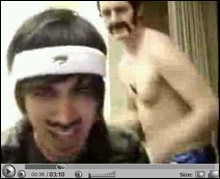
AMATEUR VIDEOS, COMMERCIAL SONGS: They may get the kibosh. |
You’ve seen them: the hundreds upon hundreds of homemade clips on YouTube and Google Video where bored teenagers set up a webcam and lip-sync cheekily to their favorite songs. There are the Chinese college students in Houston Rockets jerseys contorting with mock sincerity to the Backstreet Boys’ “I Want It That Way”; the shirtless dudes in headbands and fake mustaches shaking ass to Aqua’s “Barbie Girl”; and the wild-eyed girls from the Netherlands butchering Aretha Franklin’s “Respect.” It’s the sort of typically frivolous goofiness that a generation weaned on the Web has become used to — yet another Internet 2.0 phenomenon that’s become improbably popular.
But the kibosh may be coming down soon. According to a story in the Wall Street Journal last week, “At a May meeting of the Recording Industry Association of America [RIAA], the industry’s main trade group, the world’s largest music company, Universal Music Group, pushed for an aggressive stance against amateur videos using commercial songs.”
Almost immediately, the blogs were abuzz that YouTube lip-syncers have been served cease-and-desist notices from the RIAA demanding the posted videos be taken down. Although no one, it seems, has been in touch with anyone who has received such a letter.
When contacted, RIAA spokeswoman Amanda Hunter declined to comment (and a YouTube spokesperson could not be reached at press time). But this much at least is true: by strict letter of the law, the RIAA has the right to crack down. The songs are copyrighted, and those rights have not been cleared. And since YouTube is trying to curry favor with rights holders, the RIAA need only ask the company in order for a clip to be removed. After all, the RIAA is the same group that, in its three-year battle with file-sharers, has brought suit against a dead person, a grandmother, and a 12-year-old girl.
Moreover, attacking YouTube users would be in keeping with the RIAA’s tactics. In fact, it would simply be the latest in a relentless effort to control digital content in the new-media landscape and — at least from the point of view of the consumer — to minimize the fun that can be had with music and video. As Berkeley journalism professor John Battelle wrote on his blog (batellemedia.com), “Good f’ing lord, RIAA. Wake up. This is how we use music in the real world. Get over yourselves.”
These homemade clips are a distinct phenomenon from the professionally produced music videos that are all over YouTube, which also have the RIAA concerned. Last fall, at about the same time the labels and studios realized they could sell videos for $1.99 on iTunes and Google Video — to the tune of $3.7 million in three months, according to a Billboard article earlier this month — those same videos, captured via TiVo and uploaded by fans, began proliferating all over the Internet. The same Billboard article reported “the RIAA recently issued cease-and-desist letters to YouTube users sharing videos from the likes of Nelly Furtado, Beyoncé and Rihanna,” and has been lobbying the Web site to better police itself.